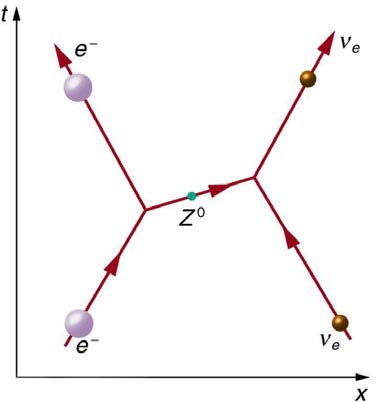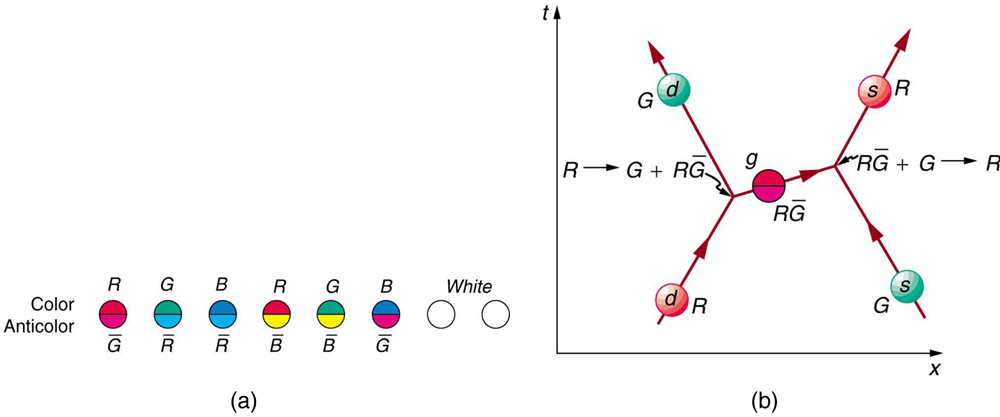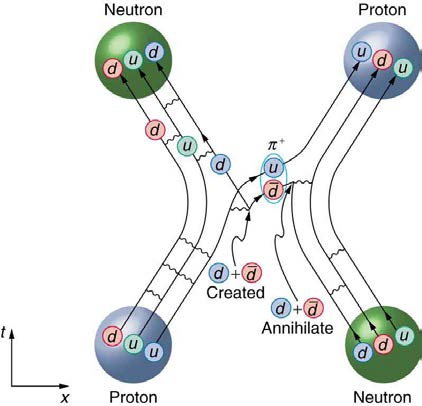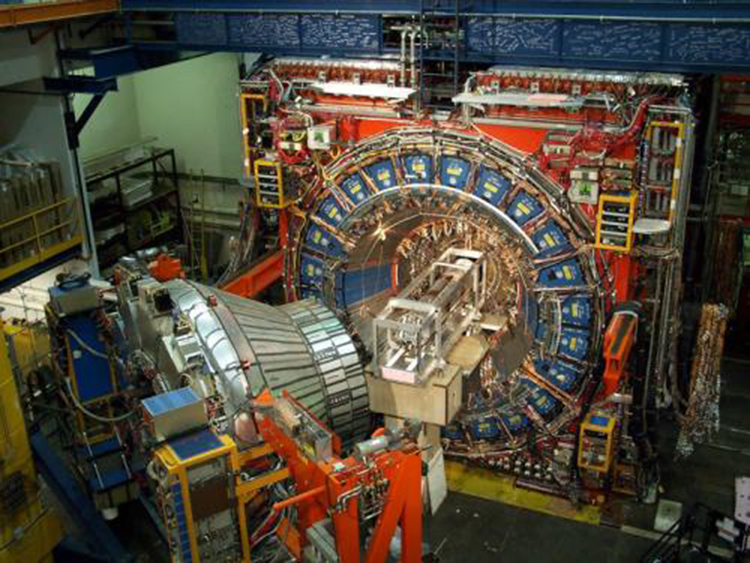special among the four forces in that it affects the space and time in which the other forces exist and is proving most difficult to include in a Theory of
Everything or TOE (to stub the pretension of such a theory). Gravity is thus often set apart. It is not certain that there is meaning in the groupings
shown in Figure 33.20, but the analogies are tempting. In the past, we have been able to make significant advances by looking for analogies and
patterns, and this is an example of one under current scrutiny. There are connections between the families of leptons, in that the τ decays into the
µ and the µ into the e. Similarly for quarks, the higher families eventually decay into the lowest, leaving only u and d quarks. We have long sought connections between the forces in nature. Since these are carried by particles, we will explore connections between gluons, W ± and Z 0 , and
photons as part of the search for unification of forces discussed in GUTs: The Unification of Forces..


CHAPTER 33 | PARTICLE PHYSICS 1199
Figure 33.20 The three types of particles are leptons, quarks, and carrier particles. Each of those types is divided into three analogous families, with the graviton left out.
33.6 GUTs: The Unification of Forces
Present quests to show that the four basic forces are different manifestations of a single unified force follow a long tradition. In the 19th century, the
distinct electric and magnetic forces were shown to be intimately connected and are now collectively called the electromagnetic force. More recently,
the weak nuclear force has been shown to be connected to the electromagnetic force in a manner suggesting that a theory may be constructed in
which all four forces are unified. Certainly, there are similarities in how forces are transmitted by the exchange of carrier particles, and the carrier
particles themselves (the gauge bosons in Table 33.2) are also similar in important ways. The analogy to the unification of electric and magnetic
forces is quite good—the four forces are distinct under normal circumstances, but there are hints of connections even on the atomic scale, and there
may be conditions under which the forces are intimately related and even indistinguishable. The search for a correct theory linking the forces, called
the Grand Unified Theory (GUT), is explored in this section in the realm of particle physics. Frontiers of Physics expands the story in making a connection with cosmology, on the opposite end of the distance scale.
Figure 33.21 is a Feynman diagram showing how the weak nuclear force is transmitted by the carrier particle Z 0 , similar to the diagrams in Figure
33.5 and Figure 33.6 for the electromagnetic and strong nuclear forces. In the 1960s, a gauge theory, called electroweak theory, was developed by Steven Weinberg, Sheldon Glashow, and Abdus Salam and proposed that the electromagnetic and weak forces are identical at sufficiently high
energies. One of its predictions, in addition to describing both electromagnetic and weak force phenomena, was the existence of the W + ,W − , and
Z 0 carrier particles. Not only were three particles having spin 1 predicted, the mass of the W + and W − was predicted to be 81 GeV/ c 2 , and
that of the Z 0 was predicted to be 90 GeV/ c 2 . (Their masses had to be about 1000 times that of the pion, or about 100 GeV/ c 2 , since the range
of the weak force is about 1000 times less than the strong force carried by virtual pions.) In 1983, these carrier particles were observed at CERN with
the predicted characteristics, including masses having the predicted values as seen in Table 33.2. This was another triumph of particle theory and experimental effort, resulting in the 1984 Nobel Prize to the experiment’s group leaders Carlo Rubbia and Simon van der Meer. Theorists Weinberg,
Glashow, and Salam had already been honored with the 1979 Nobel Prize for other aspects of electroweak theory.
Figure 33.21 The exchange of a virtual Z 0 carries the weak nuclear force between an electron and a neutrino in this Feynman diagram. The Z 0 is one of the carrier particles for the weak nuclear force that has now been created in the laboratory with characteristics predicted by electroweak theory.
Although the weak nuclear force is very short ranged ( < 10 – 18 m , as indicated in Table 33.1), its effects on atomic levels can be measured given the extreme precision of modern techniques. Since electrons spend some time in the nucleus, their energies are affected, and spectra can
even indicate new aspects of the weak force, such as the possibility of other carrier particles. So systems many orders of magnitude larger than the
range of the weak force supply evidence of electroweak unification in addition to evidence found at the particle scale.


1200 CHAPTER 33 | PARTICLE PHYSICS
Gluons ( g ) are the proposed carrier particles for the strong nuclear force, although they are not directly observed. Like quarks, gluons may be
confined to systems having a total color of white. Less is known about gluons than the fact that they are the carriers of the weak and certainly of the
electromagnetic force. QCD theory calls for eight gluons, all massless and all spin 1. Six of the gluons carry a color and an anticolor, while two do not
carry color, as illustrated in Figure 33.22(a). There is indirect evidence of the existence of gluons in nucleons. When high-energy electrons are
scattered from nucleons and evidence of quarks is seen, the momenta of the quarks are smaller than they would be if there were no gluons. That
means that the gluons carrying force between quarks also carry some momentum, inferred by the already indirect quark momentum measurements.
At any rate, the gluons carry color charge and can change the colors of quarks when exchanged, as seen in Figure 33.22(b). In the figure, a red
down quark interacts with a green strange quark by sending it a gluon. That gluon carries red away from the down quark and leaves it green,
because it is an RG
- (red-antigreen) gluon. (Taking antigreen away leaves you green.) Its antigreenness kills the green in the strange quark, and its
redness turns the quark red.
Figure 33.22 In figure (a), the eight types of gluons that carry the strong nuclear force are divided into a group of six that carry color and a group of two that do not. Figure (b) shows that the exchange of gluons between quarks carries the strong force and may change the color of a quark.
The strong force is complicated, since observable particles that feel the strong force (hadrons) contain multiple quarks. Figure 33.23 shows the quark and gluon details of pion exchange between a proton and a neutron as illustrated earlier in Figure 33.3 and Figure 33.6. The quarks within the proton and neutron move along together exchanging gluons, until the proton and neutron get close together. As the u quark leaves the proton, a
gluon creates a pair of virtual particles, a d quark and a d- antiquark. The d quark stays behind and the proton turns into a neutron, while the u
and d- move together as a π+ (Table 33.4 confirms the u d- composition for the π+ .) The d- annihilates a d quark in the neutron, the u joins the neutron, and the neutron becomes a proton. A pion is exchanged and a force is transmitted.
Figure 33.23 This Feynman diagram is the same interaction as shown in Figure 33.6, but it shows the quark and gluon details of the strong force interaction.
It is beyond the scope of this text to go into more detail on the types of quark and gluon interactions that underlie the observable particles, but the
theory ( quantum chromodynamics or QCD) is very self-consistent. So successful have QCD and the electroweak theory been that, taken together,
they are called the Standard Model. Advances in knowledge are expected to modify, but not overthrow, the Standard Model of particle physics and
forces.
Making Connections: Unification of Forces
Grand Unified Theory (GUT) is successful in describing the four forces as distinct under normal circumstances, but connected in fundamental
ways. Experiments have verified that the weak and electromagnetic force become identical at very small distances and provide the GUT
description of the carrier particles for the forces. GUT predicts that the other forces become identical under conditions so extreme that they
cannot be tested in the laboratory, although there may be lingering evidence of them in the evolution of the universe. GUT is also successful in
describing a system of carrier particles for all four forces, but there is much to be done, particularly in the realm of gravity.

CHAPTER 33 | PARTICLE PHYSICS 1201
How can forces be unified? They are definitely distinct under most circumstances, for example, being carried by different particles and having greatly
different strengths. But experiments show that at extremely small distances, the strengths of the forces begin to become more similar. In fact,
electroweak theory’s prediction of the W+ , W- , and Z 0 carrier particles was based on the strengths of the two forces being identical at extremely
small distances as seen in Figure 33.24. As discussed in case of the creation of virtual particles for extremely short times, the small distances or short ranges correspond to the large masses of the carrier particles and the correspondingly large energies needed to create them. Thus, the energy
scale on the horizontal axis of Figure 33.24 corresponds to smaller and smaller distances, with 100 GeV corresponding to approximately, 10-18 m
for example. At that distance, the strengths of the EM and weak forces are the same. To test physics at that distance, energies of about 100 GeV
must be put into the system, and that is sufficient to create and release the W+ , W- , and Z 0 carrier particles. At those and higher energies, the
masses of the carrier particles becomes less and less relevant, and the Z 0 in particular resembles the massless, chargeless, spin 1 photon. In fact,
there is enough energy when things are pushed to even smaller distances to transform the, and Z 0 into massless carrier particles more similar to
photons and gluons. These have not been observed experimentally, but there is a prediction of an associated particle called the Higgs boson. The
mass of this particle is not predicted with nearly the certainty with which the mass of the W + , W −, and Z 0 particles were predicted, but it was
hoped that the Higgs boson could be observed at the now-canceled Superconducting Super Collider (SSC). Ongoing experiments at the Large
Hadron Collider at CERN have presented some evidence for a Higgs boson with a mass of 125 GeV, and there is a possibility of a direct discovery
during 2012. The existence of this more massive particle would give validity to the theory that the carrier particles are identical under certain
circumstances.
Figure 33.24 The relative strengths of the four basic forces vary with distance and, hence, energy is needed to probe small distances. At ordinary energies (a few eV or less),
the forces differ greatly as indicated in Table 33.1. However, at energies available at accelerators, the weak and EM forces become identical, or unified. Unfortunately, the energies at which the strong and electroweak forces become the same are unreachable even in principle at any conceivable accelerator. The universe may provide a
laboratory, and nature may show effects at ordinary energies that give us clues about the validity of this graph.
The small distances and high energies at which the electroweak force becomes identical with the strong nuclear force are not reachable with any
conceivable human-built accelerator. At energies of about 1014 GeV (16,000 J per particle), distances of about 10−30 m can be probed. Such
energies are needed to test theory directly, but these are about 1010 higher than the proposed giant SSC would have had, and the distances are
about 10−12 smaller than any structure we have direct knowledge of. This would be the realm of various GUTs, of which there are many since there
is no constraining evidence at these energies and distances. Past experience has shown that any time you probe so many orders of magnitude
further (here, about 1012 ), you find the unexpected. Even more extreme are the energies and distances at which gravity is thought to unify with the
other forces in a TOE. Most speculative and least constrained by experiment are TOEs, one of which is called Superstring theory. Superstrings are
entities that are 10−35 m in scale and act like one-dimensional oscillating strings and are also proposed to underlie all particles, forces, and space
itself.
At the energy of GUTs, the carrier particles of the weak force would become massless and identical to gluons. If that happens, then both lepton and
baryon conservation would be violated. We do not see such violations, because we do not encounter such energies. However, there is a tiny
probability that, at ordinary energies, the virtual particles that violate the conservation of baryon number may exist for extremely small amounts of
time (corresponding to very small ranges). All GUTs thus predict that the proton should be unstable, but would decay with an extremely long lifetime
of about 1031 y . The predicted decay mode is
(33.11)
p → π 0 + e+, (proposed proton decay)
which violates both conservation of baryon number and electron family number. Although 1031 y is an extremely long time (about 1021 times the
age of the universe), there are a lot of protons, and detectors have been constructed to look for the proposed decay mode as seen in Figure 33.25. It is somewhat comforting that proton decay has not been detected, and its experimental lifetime is now greater than 5×1032 y . This does not prove
GUTs wrong, but it does place greater constraints on the theories, benefiting theorists in many ways.
From looking increasingly inward at smaller details for direct evidence of electroweak theory and GUTs, we turn around and look to the universe for
evidence of the unification of forces. In the 1920s, the expansion of the universe was discovered. Thinking backward in time, the universe must once
have been very small, dense, and extremely hot. At a tiny fraction of a second after the fabled Big Bang, forces would have been unified and may
have left their fingerprint on the existing universe. This, one of the most exciting forefronts of physics, is the subject of Frontiers of Physics.

1202 CHAPTER 33 | PARTICLE PHYSICS
Figure 33.25 In the Tevatron accelerator at Fermilab, protons and antiprotons collide at high energies, and some of those collisions could result in the production of a Higgs
boson in association with a W boson. When the W boson decays to a high-energy lepton and a neutrino, the detector triggers on the lepton, whether it is an electron or a muon. (credit: D. J. Miller)
Glossary
baryon number: a conserved physical quantity that is zero for mesons and leptons and ±1 for baryons and antibaryons, respectively
baryons: hadrons that always decay to another baryon
boson: particle with zero or an integer value of intrinsic spin
bottom: a quark flavor
charm: a quark flavor, which is the counterpart of the strange quark
colliding beams: head-on collisions between particles moving in opposite directions
color: a quark flavor
conservation of total baryon number: a general rule based on the observation that the total number of nucleons was always conserved in
nuclear reactions and decays
conservation of total electron family number: a general rule stating that the total electron family number stays the same through an interaction
conservation of total muon family number: a general rule stating that the total muon family number stays the same through an interaction
cyclotron: accelerator that uses fixed-frequency alternating electric fields and fixed magnets to accelerate particles in a circular spiral path
down: the second-lightest of all quarks
electron family number: the number ±1 that is assigned to all members of the electron family, or the number 0 that is assigned to all particles
not in the electron family
electroweak theory: theory showing connections between EM and weak forces
Feynman diagram: a graph of time versus position that describes the exchange of virtual particles between subatomic particles
fermion: particle with a half-integer value of intrinsic spin
flavors: quark type
fundamental particle: particle with no substructure
gauge boson: particle that carries one of the four forces
gluons: exchange particles, analogous to the exchange of photons that gives rise to the electromagnetic force between two charged particles
gluons: eight proposed particles which carry the strong force
grand unified theory: theory that shows unification of the strong and electroweak forces
Higgs boson: a massive particle that, if observed, would give validity to the theory that carrier particles are identical under certain circumstances
CHAPTER 33 | PARTICLE PHYSICS 1203
hadrons: particles that feel the strong nuclear force
leptons: particles that do not feel the strong nuclear force
linear accelerator: accelerator that accelerates particles in a straight line
meson: particle whose mass is intermediate between the electron and nucleon masses
meson: hadrons that can decay to leptons and leave no hadrons
muon family number: the number ±1 that is assigned to all members of the muon family, or the number 0 that is assigned to all particles not in
the muon family
particle physics: the study of and the quest for those truly fundamental particles having no substructure
pion: particle exchanged between nucleons, transmitting the force between them
quantum chromodynamics: quark theory including color
quantum chromodynamics: the governing theory of connecting quantum number color to gluons
quantum electrodynamics: the theory of electromagnetism on the particle scale
quark: an elementary particle and a fundamental constituent of matter
standard model: combination of quantum chromodynamics and electroweak theory
strangeness: a physical quantity assigned to various particles based on decay systematics
strange: the third lightest of all quarks
superstring theory: a theory of everything based on vibrating strings some 10−35 m in length
synchrotron radiation: radiation caused by a magnetic field accelerating a charged particle perpendicular to its velocity
synchrotron: a version of a cyclotron in which the frequency of the alternating voltage and the magnetic field strength are increased as the beam
particles are accelerated
tau family number: the number ±1 that is assigned to all members of the tau family, or the number 0 that is assigned to all particles not in the
tau family
theory of quark confinement: explains how quarks can exist and yet never be isolated or directly observed
top: a quark flavor
up:
the lightest of all quarks
Van de Graaff: early accelerator: simple, large-scale version of the electron gun
virtual particles: particles which cannot be directly observed but their effects can be directly observed
Section Summary
33.0 Introduction to Particle Physics
• Particle physics is the study of and the quest for those truly fundamental particles having no substructure.
33.1 The Yukawa Particle and the Heisenberg Uncertainty Principle Revisited
• Yukawa’s idea of virtual particle exchange as the carrier of forces is crucial, with virtual particles being formed in temporary violation of the
conservation of mass-energy as allowed by the Heisenberg uncertainty principle.
33.2 The Four Basic Forces
• The four basic forces and their carrier particles are summarized in the Table 33.1.
• Feynman diagrams are graphs of time versus position and are highly useful pictorial representations of particle processes.
• The theory of electromagnetism on the particle scale is called quantum electrodynamics (QED).
33.3 Accelerators Create Matter from Energy
• A variety of particle accelerators have been used to explore the nature of subatomic particles and to test predictions of particle theories.
• Modern accelerators used in particle physics are either large synchrotrons or linear accelerators.
• The use of colliding beams makes much greater energy available for the creation of particles, and collisions between matter and antimatter
allow a greater range of final products.
33.4 Particles, Patterns, and Conservation Laws
1204 CHAPTER 33 | PARTICLE PHYSICS
• All particles of matter have an antimatter counterpart that has the opposite charge and certain other quantum numbers as seen in Table 33.2.
These matter-antimatter pairs are otherwise very similar but will annihilate when brought together. Known particles can be divided into three
major groups—leptons, hadrons, and carrier particles (gauge bosons).
• Leptons do not feel the strong nuclear force and are further divided into three groups—electron family designated by electron family number
Le ; muon family designated by muon family number Lµ ; and tau family designated by tau family number Lτ . The family numbers are not
universally conserved due to neutrino oscillations.
• Hadrons are particles that feel the strong nuclear force and are divided into baryons, with the baryon family number B being conserved, and
mesons.
33.5 Quarks: Is That All There Is?
• Hadrons are thought to be composed of quarks, with baryons having three quarks and mesons having a quark and an antiquark.
• The characteristics of the six quarks and their antiquark counterparts are given in Table 33.3, and the quark compositions of certain hadrons are
given in Table 33.4.
• Indirect evidence for quarks is very strong, explaining all known hadrons and their quantum numbers, such as strangeness, charm, topness,
and bottomness.
• Quarks come in six flavors and three colors and occur only in combinations that produce white.
• Fundamental particles have no further substructure, not even a size beyond their de Broglie wavelength.
• There are three types of fundamental particles—leptons, quarks, and carrier particles. Each type is divided into three analogous families as
indicated in Figure 33.20.
33.6 GUTs: The Unification of Forces
• Attempts to show unification of the four forces are called Grand Unified Theories (GUTs) and









